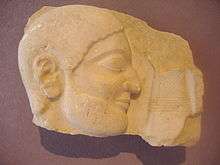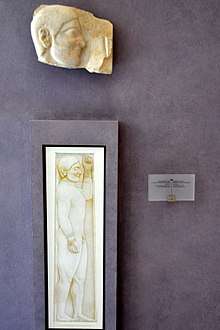Boxer Stele Fragment from Kerameikos


This marble fragment of a funerary stele depicting a boxer is dated at circa 540 BCE.[1] The individual's depiction as a boxer is apparent in his broken nose, cauliflower ear, and the strapped wrist that he holds aloft - these straps were used by the Ancient Greeks to secure knuckle-guards for boxing competitions.[2] It is considered one of the earliest examples of a highly individualized athlete depiction in Ancient Greek sculpture.[3] It utilizes relief carving techniques to characterize a subject long before high degrees of individual characterization were apparent in freestanding sculpture.[2]
Discovery
The stele fragment was discovered in 1953 by Threpsiades, in the remains of Athens' Themistoklean Walls. It hangs today in the Kerameikos Archaeological Museum.[4]
Boxing in Ancient Greece
In ancient Greece, there were very few rules in boxing - it was a brutal sport. Gloves were not typical in the ancient Greek version of the sport; rather, fighters wore himantes, or leather thongs, around their wrists and the lower part of their hands to protect them from damage. In Plato's Gorgias, he refers to them as "folk with the battered ears," referencing their tendency to become disfigured by violence, like the cauliflower ears depicted in the stele[5] In fact, it was not unusual for a fighter to become seriously injured or even killed in this ancient sport.[6]
Other Ancient Greek Depictions of Boxing
This stele fragment's subject can be compared to the notable Boxer at Rest, also known as the Terme Boxer. Unlike the boxer stele, which is in relief and of marble, this sculpture was made in the round and of bronze and copper inlay. This sculpture further depicts the detrimental physical effects of ancient Greek boxing - while the stele only has cauliflower ears, Boxer at Rest has cauliflower ears, a broken nose, and cuts and scrapes emphasized from the statue's bronze composition with inlay of copper. The extra detail and intricacy of Boxer at Rest contributes to its pathos, or emotional effect on the viewer.[7]
References
- ↑ "GALLERY". www.fhw.gr. Retrieved 2017-10-30.
- 1 2 T.,, Neer, Richard. Greek art and archaeology : a new history, c. 2500-c. 150 BCE. New York. ISBN 9780500288771. OCLC 745332893.
- ↑ Jeffery, L. H. (November 1, 1964). "Karusos (C.)Aristodikos: zur Geschichte der spätarchaisch-attischen Plastik und der Grabstatue. Stuttgart: W. Kohlhammer. 1961. Pp. viii + 96. 16 plates. 2 text figures. DM 18". The Journal of Hellenic Studies. 84: 231–232. doi:10.2307/627789. ISSN 2041-4099.
- ↑ "Wrestler from the Kerameikos". www.davidgill.co.uk. Retrieved 2017-10-30.
- ↑ "Ancient Sports: Boxing". www.perseus.tufts.edu.
- ↑ "The Bloody, Deadly, Heavy Fights of Ancient Greece | FIGHTLAND". Fightland. Retrieved 2017-12-03.
- ↑ "The Boxer: An Ancient Masterpiece Comes to the Met". The Metropolitan Museum of Art, i.e. The Met Museum. Retrieved 2017-12-03.